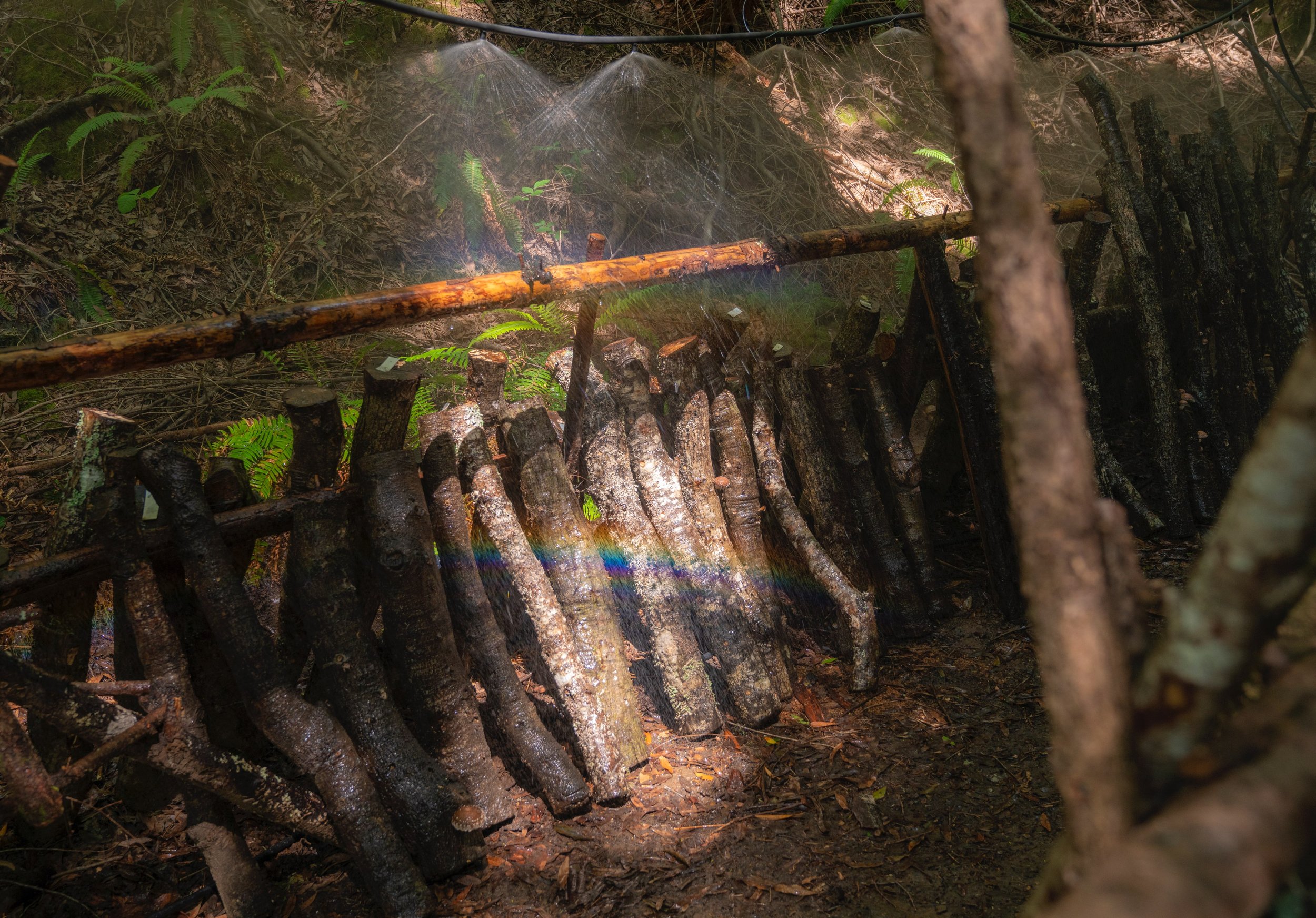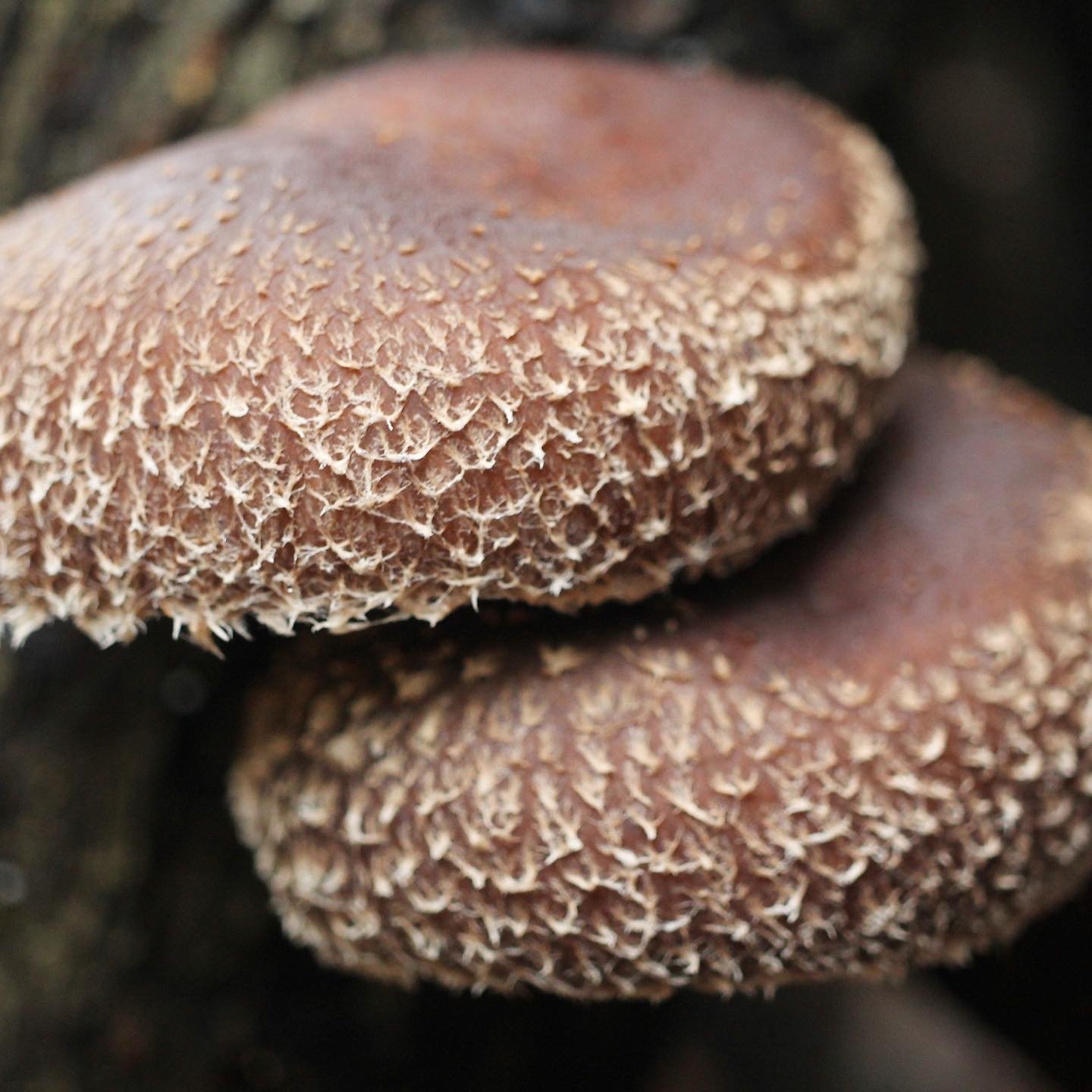
We grow all of our mushrooms outdoors, on logs.
Yes, this means all of our mushrooms come from logs, outdoors, year-round. Exceptionally minimal plastic, no UV lights, no climate-controlled rooms, no autoclaves.
Just the seasons and cycles of the forest.
We currently have 7 different varieties of shiitake (Lentulina edodes) in production, with reishi (Ganoderma lucidum) beginning to fruit and lion’s mane (Hericium erinaceus) on the way!
We are re-membering the way of mushroom farming
A conventional mushroom farm producing oysters in China
Despite the gift of having more and more mushrooms in our marketplaces and in produce sections in many places of the world, most modern day, large-scale, “conventional” mushroom farms have enormous waste and energy footprints.
Many indoor farms grow their mushrooms out of single use, disposable and non-recyclable plastic bags, commonly called “unicorn bags.” There can be hundreds, even thousands, of these bags discarded every day from one facility. Not to mention the incessant use of energy, fueling giant machines for sterilization, artificial light and humidity/temperature control.
These are some of the reasons why we chose to make our farm a small, log-cultivation operation. We wanted to stay as close to the land and it’s cycles as possible, providing nutrient dense medicinal and edible fungi for the community without all the added baggage.
Chinese sage in contemplation of Ling Zhi (Reishi). Painted by Chen Hung-shou (1559-1652).
Mushroom cultivation is an ancient art of ecological participation, with the first recorded mentions of mushroom cultivation 3,000 years ago from China in the Chou Dynasty. The practices involved are presumed to have begun well before the written record.
Log cultivation has been practiced for millennia. At its core, it is the art of mimicking natural processes and in-situ fungal ecology. Early medicine peoples, foragers and curious cultivators in China would notice edible and medicinal mushrooms like shiitake, wood ear and reishi growing out of logs in the forest and began to experiment with inoculating logs manually to replicate what they saw. Biomimicry is not a new concept. This is but one of the many gifts we have inherited, dendritically extending from keen observation and careful investigation by indigenous peoples ages ago and for which we are incredibly grateful.
Now the art of log cultivation is practiced all over the world, from productive farms to backyard gardens. While industrial-scale indoor farms far outnumber those who are growing outdoor on logs, we hope to offer our humble hands in tipping the scales back towards this ancient, regenerative, and effective way of growing mushrooms.
With log cultivation, the need for plastic is incredible minimal; it’s the log, the fungal mycelium, a moveable plastic sheet for holding in moisture, and a little bit of non-GMO, biodegradable wax that covers the inoculation holes.
Once the wood is “eaten” by the fungi and is no longer able to produce mushrooms, the logs’ tough lignin that it relies on for structural integrity is broken down, decomposes, and re-enters the nutrient cycling processes of the forest ecosystem, becoming part of the next generation of fertile soil, just like in a forest setting. Meanwhile, the mushrooms and the logs are participating in the forest ecology, just as we do.
This is how lignicolous saprotrophic fungi have been making soil and cycling nutrients on the planet for millennia. Without their alchemical magic, life on the planet would look a lot different than we see it today. What we practice at Moon Fruit is just a small part of a long story, facilitating ancient processes that give back to the land as the land gives back to us.
Meet your friendly, neighborhood mushroom farmers
Cory Brown Co-owner
Living in the forest (of Southern Pomo/ Coast Miwok peoples) for over 8 years, the mushroom farm was a natural development of the overarching desire to tend the land while providing food and medicine for myself, my friends, and my local community.
I enjoy creating things with focus and heart, looking for that blend between art, usefulness, and healing, for ourselves and the land. Tending the mushroom farm has become a great joy in my life, with the added bonus of a seemingly unending supply of fresh shiitake!
On the farm, I mostly fill the niche of “the engineer”, leading the building and designing of our systems, while also care-taking the logs through incubation, and monitoring their health and harvests.
Ryath Fujita Beauchene Co-owner
I had thought about starting a mushroom farm for years, but it wasn’t until Cory asked me to team up that I knew it was time.
I trust mushrooms; they have exquisitely entrapped and psychosomatically rearranged my entire being for the better. I am now their servant, ever-willing. I love blending my knowledge and experience of wild mushroom seeking and identification with the world of cultivation; each practice enriches the other.
I’m something of a generalist at the farm, moving where the energy is needed for the tasks at hand, and, with this team, I’m happy to do all of it.
Taylor Bright Co-owner
My life-long curiosity about the natural world has led me to the dynamic world of mycology, and I have been able to make my life and living devoted to our fungal allies. I am a full time, bonafide mushroom nerd working on everything from cultivating fungal food & medicine, doing post-fire mycoremediation research, running my business making/selling mushroom medicine and art, leading workshops, guiding mushroom walks, educating, and of course the mushroom farm!
At the farm, I can be found singing to the forest while harvesting, intently observing morphological traits and fruiting patterns, and gathering turkey tail from our volunteer logs for medicine. I am the primary medicine maker at the farm; using my modern day witchery skills to make tinctures, blends, and help develop new ideas for our offerings.
My prayer for the farm and beyond is to illuminate the importance of inter-species relating and how we can be healing agents within the human and other-than-human communities we live with. There is no deeper joy for me than creating the conditions conducive to grow food & medicine which has the potential to deeply heal body and land.

Origin Story
In 2018, Ryath and Cory decided that they wanted more mushrooms in their lives - to eat, yes, but also to gaze and marvel at, to photograph, to cherish, and to bring fungal food and medicine to their loved ones and wider community circles.
This led them to the forest, where they mindfully hand-harvested the first logs of the farm and plugged them with shiitake spawn - the humble beginnings of Moon Fruit Mushroom Farm.
Immediately after, a timber-framed greenhouse was built and filled with reishi logs the following year. Annually, more shiitake has been inoculated and lion’s mane joined the team. At the end of 2019 Taylor joined as a co-owner, and we now have about 600 shiitake logs in production with 200 more on the way in spring. The reishi is beginning to fruit and the lion’s mane ‘totems’ are in their final period of incubation (with hopes of spring sporocarps!)
We sell our fresh shiitake locally in Sebastopol, CA through the Green Valley Farm + Mill Marketplace and on consignment at the Sonoma County Herb Exchange.
We also sell our shiitake furikake & triple extraction shiitake/turkey tail tinctures through the marketplace and Instagram.











